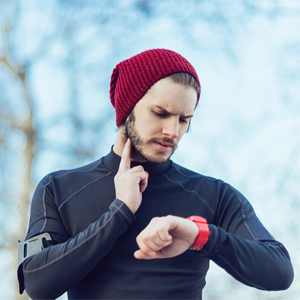
The most common wisdom was to subtract your age from 220, and – voilà! – you had your max HR, a figure representing the greatest number of beats per minute your heart can achieve.
Then, from that number, you could allegedly calculate your recovery, fat-burning, lactate threshold and anaerobic heart-rate training zones.
However, it’s a rudimentary system – like, “might as well use an abacus as a bike computer” rudimentary.
“It’s been the standard for years but there are a lot of variables” that can throw off your max HR, says Cherie Miner, MD, a sports medicine physician and age-group Ironman athlete at Andrews Sports Medicine and Orthopedic Center.
She adds that how fit you are, how hot it is, and how much stress you’re under can all affect your max HR at any given time.
Like the 220-minus-age rule, there are a lot of other myths surrounding max HR. Here, we debunk the worst of them.
1. If you go over your max HR, your heart explodes
You’ve got to admit, this would be horrifying if true. Rest easy, though – it won’t happen.
“Your heart gets to the point where it can’t eject blood effectively enough; where it’s not productive anymore,” says Dean Golich, head performance physiologist for Carmichael Training Systems.
When this happens, self-preservation kicks in and you slow down. If you’re in a race, that means you’ll either just get dropped or toss your cookies.
“Most people have one to two minutes max at their max HR; highly trained athletes may have more,” says Miner.
Expect to see your performance suffer very quickly if you try and maintain your max HR for more than just a short burst.
2. Your max HR is the same for everyone your age
That’s what the old-school formulas assume, but Golich says it’s much more nuanced than that. Max HR is largely untrainable, and determined by genetics – some of us have hearts tuned like humming birds’ while others have the slow and steady type.
“But it’s not an indication of performance,” Golich says. “If your max is 200 and someone else’s is 190, it doesn’t mean one of you is the better athlete.”
In fact, he’s worked with numerous talented athletes at both ends of the spectrum.
It’s good to remember that everyone’s max HR does drop as they age – but again, that doesn’t mean you’re losing fitness. Regular training and good nutrition will affect performance more than the fact that your max HR is now slightly lower than it was three years ago.
In reality, it’s not your max HR that determines your fitness level: Being able to hold your max HR for longer and longer sessions is what’s key.
3. Heart rate is a measurement of how hard you’re working
Heart rate is a reaction to work being done, not a measurement of actual work.
For example, Golich says that if you ratchet yourself up to 200 watts for three minutes, for the first minute, your heart may tick along at 170bpm; by minute two it may be at 180; and by minute three you could be pushing 189. But you’re doing the same amount of work the whole time – 200 watts.
If you were to ride for three minutes with the intention of maintaining the same heart rate, things would look different. Say you ramped up to 180bpm to start – you might ride at 200 watts for the first minute, but you’d likely have to drop your watts to sustain that heart rate for minutes two and three.
Golich himself prefers to have his clients train with power meters or using Rate of Perceived Exertion (RPE) – simply, a personal appraisal of how hard you feel you’re working – rather than HR.
“There are a lot of grey areas,” with heart rate, he says, adding that being overheated, under-fuelled, or even just hopped up on caffeine will throw your heart rate numbers off for the day.
Furthermore, the number displayed by your heart-rate monitor or the screen on a gym treadmill may not be accurate. Sure, using a computer is certainly more accurate than the 220-age formula, but Golich adds says that since these devices take measurements every few seconds, they’re probably not dead-on.
If you really want to know your true max heart rate, an EKG is the best way to go, though Golich believes it’s not an expense worth taking on.
4. If I’m not working at my max heart rate, I’m not working hard enough
Here’s your license to chill. Max heart-rate workouts should be done sparingly, says Miner, since the ultra-high intensity can lead to injuries, extreme fatigue and other symptoms of overtraining.
Plus, there’s merit to working in many different heart-rate zones – from increasing your base fitness with low-intensity sessions to pushing the boundaries at your lactate threshold, and even tipping into some anaerobic work.
If you only have two speeds – hard and really hard – you’re doing yourself a disservice.
5. As long as you’re working under your max, you don’t have to worry about a cardiac incident
Not true. Heart attacks, while rare, happen to athletes at all different workloads. Even so, cardiologist James Beckerman, MD, says you’re slightly more at risk when working at very high intensities.
“This is likely related to a combination of high heart rate; higher blood pressure with exercise, which is normal; and higher levels of catecholamine [a hormone produced by the adrenal gland],” he says. “For people without heart disease, exercising at higher intensity is generally safe.”
If you’re someone with heart disease or who’s exhibited risk factors, however, it’s a good idea to talk to your doctor about safe heart-rate ranges for exercise and even get a stress test, he says.
6. Your max HR is the same for all sports
You’re not paranoid: Your max for cycling really may be different than your max for swimming.
Again, this is indicative of how variable heart rate is, says Golich. Things that are load bearing – like running – will generally push your heart rate higher, since you have to do more work to overcome gravity.
Cycling, because it has the mechanical assist of bike wheels, will generally produce a lower max heart rate. And swimming, which happens in a pool with zero-impact, may be lower still: Since the water is keeping you cool, Golich says, heat will be less of a factor in raising your HR.
This article was originally featured on www.bicycling.co.za
Image credit: iStock




 Publications
Publications
 Partners
Partners














